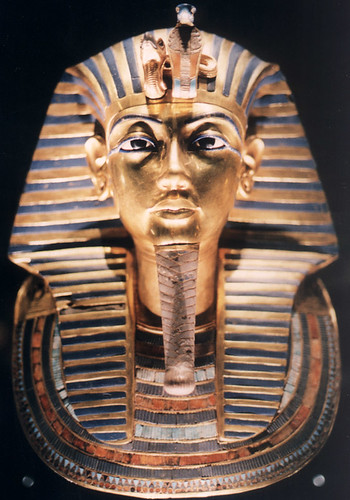 From the shimmering death mask of King Tut to the swinging penile replacements of 50 Cent, Gold and silver have been as staple pursuits of humanity as food, drugs and celebrity gossip. But while the dripping opulence of the ancient world may not seem a million miles away from the crass overindulgence of our own ‘enlightened’ age, you might be surprised to find that the two metals have almost exactly the same value now as they did then. According to economist Jeff Clark, that is. When faced with the notion gold was a dead investment, Clark looked at historical valuations of both metals, concluding their value has changed very little since the first known pricing of gold during the 1st Dynasty of Egypt in 3,100 BC – and the subsequent gold crush that gripped the empire for millennia.
From the shimmering death mask of King Tut to the swinging penile replacements of 50 Cent, Gold and silver have been as staple pursuits of humanity as food, drugs and celebrity gossip. But while the dripping opulence of the ancient world may not seem a million miles away from the crass overindulgence of our own ‘enlightened’ age, you might be surprised to find that the two metals have almost exactly the same value now as they did then. According to economist Jeff Clark, that is. When faced with the notion gold was a dead investment, Clark looked at historical valuations of both metals, concluding their value has changed very little since the first known pricing of gold during the 1st Dynasty of Egypt in 3,100 BC – and the subsequent gold crush that gripped the empire for millennia.
First let’s go back a little less far, to the 6th century AD and Muhammed, founder of Islam. During his time, a chicken cost one silver dirham, or three grams. Skip forward 1,400 years, says Clark, and you can still get a chicken in the Middle East for around the price of three grams of silver. Jumping back another 600 years, Clark claims that an ounce of gold bought a Roman citizen his toga, leather belt and a pair of sandals. Again, an ounce of the good stuff today would get you around $953 (578), which would buy you a great designer suit, belt and shoes (Mr Clark clearly doesn’t buy his suits from the supermarket!). So far so workable, if a little flimsy.
Clark’s next stop takes him back to the reign of the irrepressible Babylonian tenure of Nebuchadnezzar. It’s the turn of the 7th century BC, and Old Neb is famed for his ostentatious gold statues and decadence. According to ‘some scholars’, an ounce of gold was enough to buy you 350 loaves of bread. Working on the rounded figure of $950 (575) for the gold ounce, Clark reckons you can still buy almost exactly 350 loaves today. And at around $2.73 (1.65) per loaf, it’s hard to argue with his working.
The final historical frontier in Clark’s theory sees him dashing back to the 10th century BC when Solomon, King of Israel, bought a huge number of horses in Egypt for 150 shekels, or 55 Troy ounces of silver (Troy weight is one of a few traditional units for measuring gold and silver; named after the French city of Troyes). I think you can guess where Clark is going he claims you can still buy a riding horse for 55 ounces of silver, or around $780 (473). After taking a brief peek at the wonderfully-named website HorseMart, Clark’s assertion seems to hold sway. 473 wouldn’t buy you a National winners’ pancreas, but you can get the cheapest nags for about 500.
It seems there’s more than a little to Mr Clark’s theory, and I’d certainly be waving the white flag were I the person who ticked him off! Gold’s been making more than a cameo appearance at HK not least in the tangled beauty (or gaudiness) of Marc Quinn’s ‘Siren’ (Kate Moss to you and I). Jeff Koons’ Michael Jackson statue was another example of humanity’s unending love affair with the bright stuff. Think OTT dripping gold ornaments are consigned to the ancient world? Think again.
